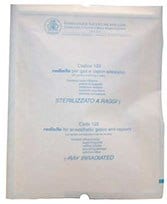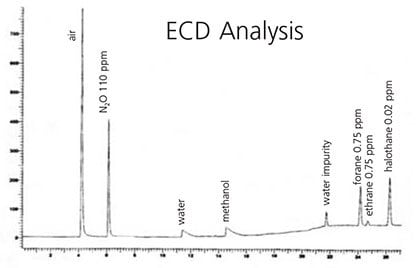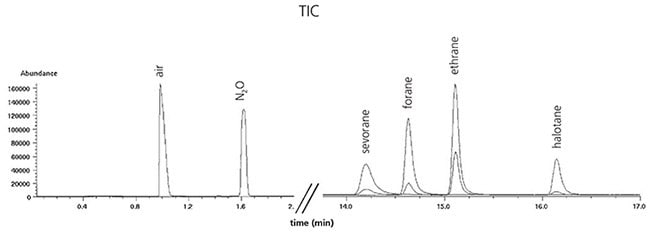radiello® Diffusive Air Sampling Application - Anaesthetic Gases and Vapors
radiello® Components Used:
Sampling kit Product No. RAD125, containing 10 single packages each composed of:
1 permeative body (Product No. RAD1203)
1 supporting plate (Product No. RAD121)
1 vertical adapter (Product No. RAD122)
1 adsorbing cartridge (Product No. RAD132)
The listed components are contained in a closed aluminum envelope, which is wrapped by a thermowelded paper-polyethylene bag.
The whole is sterilized by γ-rays.
The single components are also available non-sterilized in 10 pieces per package.

Sampling Kit Product No. RAD125
Principle
Cartridge RAD132 is made of stainless steel net loaded with a mixture of molecular sieve and activated charcoal 35-50 mesh.
Nitrous oxide and halogenated anaesthetic gases permeate the silicone membrane and are sampled by the molecular sieve and by activated charcoal respectively.
The sampled compounds are displaced by a water-methanol mixture and are quantified by capillary gas chromatography and a headspace sampler.
N2O, isoflurane, ethrane and halothane are detected by the Electron Capture Detector (ECD) with very good sensitivity; sevorane can not be quantified by ECD detection and has to be analyzed by mass spectrometry.
Sampling Rates
Sampling rate values Q at 298 K (25 °C) and 1013 hPa are listed in the table on the right.
Effect of Temperature, Humidity and Wind Speed
Sampling rate varies from the values at 298 K on the effect of temperature (in Kelvin) as expressed by the following equation:

where QK is the sampling rate at temperature K and Q298 is the sampling rate value at reference temperature of 298 K. This yields a ± 5% variation of Q for a 10 °C variation (upwards or downwards) from 25 °C.
Sampling rate is invariant with humidity in the range 10 - 90% for exposure time not exceeding 8 hours and with wind speed between 0.1 and 10 m·s-1.
Calculations
Concentration in air is obtained by the following equation:

where:
C = concentration in mg·m-3
m = mass of analyte found on the cartridge in μg
QK = sampling rate in ml·min-1
t = exposure time in minutes
Exposure
Sampling rate is constant for exposure time up to 8 hours at relative humidity up to 80% with N2O concentration up to 500 ppm and overall halogenated anaesthetic compounds concentration up to 100 ppm.
Exposure time longer than 8 hours in presence of relative humidity higher than 80% leads to the loss of the nitrous oxide already sampled by the effect of competing water vapour adsorption on the molecular sieve sites.
Limit of Detection and Uncertainty
The cartridges are conditioned to ensure a chromatographic blank level lower than three times the instrumental noise at the minimum attenuation.
If a well conditioned ECD is employed, 4 hours of exposure ensure the following analytical sensitivities: 0.5 ppm of N2O, 0.002 ppm of forane, 0.01 ppm of ethrane and 0.002 ppm of halothane. Sevorane is not detected by ECD. The Flame Ionisation Detector (FID) can be employed instead with acceptable sensitivity, but if nitrous oxide and the other halogenated compounds have to be quantified at the same time, a mass spectrometry detector must be used. Acquiring by the SIM (Single Ion Monitoring) technique detection limits close to the ECD performances can be achieved for N2O, forane, ethrane and halothane. For sevorane, 1 hour exposure allows to detect 0.1 ppm.
The uncertainty at 2σ is: 5.5% for N2O, 4.7 - 5.6% for forane, ethrane and halothane with ECD detection, 6.2% for N2O and 5.5 - 6.2% for forane, ethrane, halothane and sevorane with MS detection.
Storage
Sampling kit RAD125 is sterilized by γ-rays. Use of the sampler makes it no longer sterile. With the exception of the adsorbing cartridge, the sampler is indefinitely re-usable. After the first sampling, if you can arrange for sterilization by yourselves you only need to re-order RAD132 cartridges to perform other sampling campaigns. Adsorbing cartridges need not to be sterile.
If kept in a dry place free from chemical contamination, the cartridges are stable for at least 12 months.
After the sampling, the cartridges are stable for 30 days if stored with the same precautions.
IMPORTANT
DO NOT STERILIZE THE SAMPLER BY AUTOCLAVING.
Autoclaving treatment permanently damages the silicone permeative membrane.
Analysis
Materials Needed For the Analysis
- 20 ml headspace glass vials with open-top aluminum crimp caps and rubber/PTFE septa
- Water/methanol mixture 60/40 v/v
- Usual laboratory glassware
Materials Needed For the Calibration Curve
- Pure N2O in a gas cylinder
- Halogenated anaesthetic compounds
- Gastight syringe (volume 500 μL) and other syringes (volume 100 and 10 μL)
- 1 liter glass bottle with threaded neck, equipped with open-top screw cap and rubber/PTFE septum (the volume of the bottle must be precisely measured and the bottle must be rinsed with dry nitrogen before use)
- Magnetic stirrer with large magnetic stirring bar (about 30-40 mm long)
- Usual laboratory glassware
Extraction
Introduce 10 ml of water/methanol mixture in a headspace vial by a volumetric pipette. Add the radiello® cartridge and cap immediately. Stir and let equilibrate, place the vial in the headspace bath and let equilibrate for one hour at 45 °C.
Instrumental Analysis
ECD Detection (sevorane is not detected)
- Vial pressurization gas: N2 at 1.2 atm
- Loop volume: 1 ml
- Gas chromatographic column: polystyrene-divinylbenzene PLOT, 30 m x 0.32 mm, film 20 μm (e.g. Supel-Q-PLOT, Product no. 24242) (allows quantification of nitrous oxide and other anaesthetic gases in one chromatographic run)
- carrier gas: N2 at 1.0 atm
- Split ratio: 10/1
- Make-up gas: Ar-CH4 (CH4 10% v/v) at 30 ml·min-1
- GC oven: 40 °C for 2 min, 10 °C·min-1 up to 150 °C, 6 °C·min-1 up to 200 °C, final isotherm for 5 minutes
- Injector temperature: 150 °C
- Detector temperature: 300 °C
In the described analytical conditions chromatogram similar to the one in the figure are obtained. In the example shown, exposure time was 4 hours at the concentration values indicated and with relative humidity of 70%.
MS Detection
The instrumental conditions are as described above, with the exception of the carrier gas (helium has to be used instead) and the make-up gas, which is not employed. Acquire by SIM (Single Ion Monitoring) focusing the detector on the following signals (the base peak is bold): N2O: 44; forane and ethrane: 51, 67, 117; halothane: 117, 198, 179; sevorane: 33, 131, 181
If high concentrations of CO2 interfere (it gives a strong signal at m/z 44), N2O can be quantified basing on the signal at m/z 30. At the right a typical GC-MS chromatogram (as total ion current) is displayed. It can be observed that, as an effect of the vacuum applied on the detector end of the column, retention times are shorter with respect to those obtained with ECD detection

Calibration
Calibration curves for N2O and halogenated anaesthetics can be prepared simultaneously.
Draw pure N2O in a gas sampling bulb. Transfer 20 ml of pure N2O in the 1 liter bottle through the septum by a gastight syringe. Switch on the magnetic stirrer and let the mixture equilibrate for 30 minutes.

Standard solutions of the halogenated compounds must be prepared in water/methanol 60/40 v/v in order to contain from 0.05 to 3.0 mg/L of each compound; five calibration levels are recommended.
For each level pipet 10 ml of calibration solution in an empty vial, add a blank RAD132 cartridge and cap immediately.
Add also a precisely measured volume of diluted N2O drawn from the bottle by a gastight syringe (usually added volume ranges from 50 to 1,000 μL), stir and let equilibrate at 45 °C for 1 hour.
The values above generally comprise the usual conditions of operating theatres. The analyst may choose different values if needed, but equivalent exposure values should not exceed 400,000 mg·m-3·min for nitrous oxide and 50,000 mg·m-3·min for each of the halogenated compounds.
Note: the ECD response may not be linear. If this should be the case, use a second order calibration curve.
如要继续阅读,请登录或创建帐户。
暂无帐户?